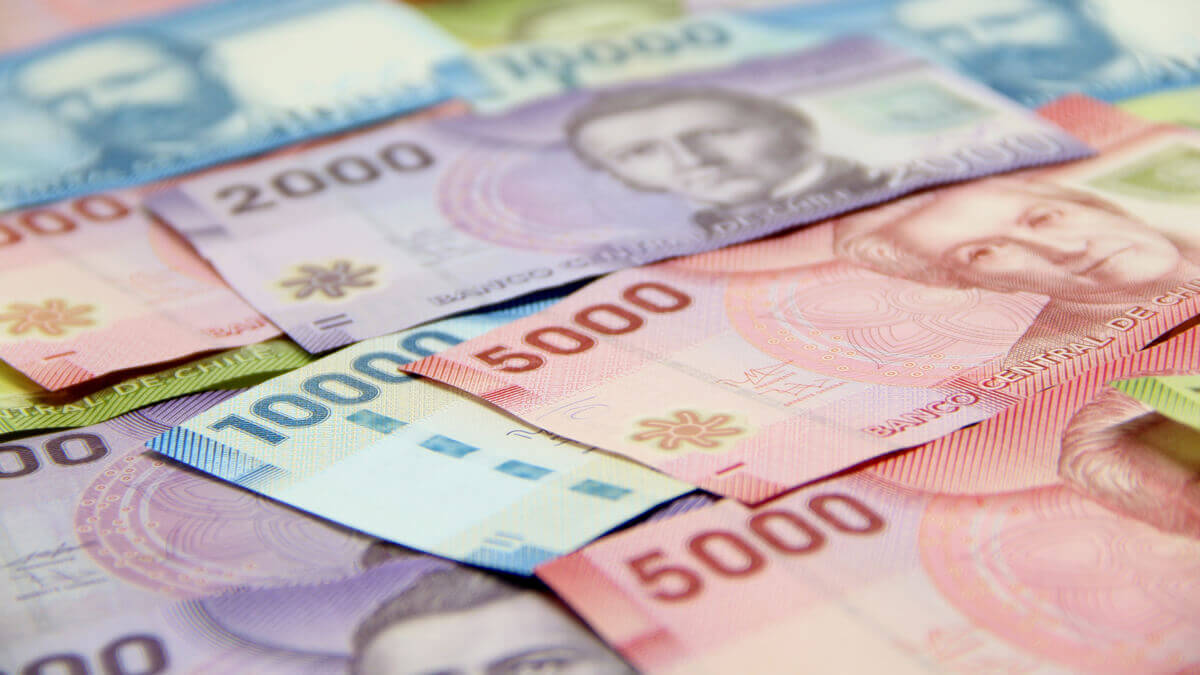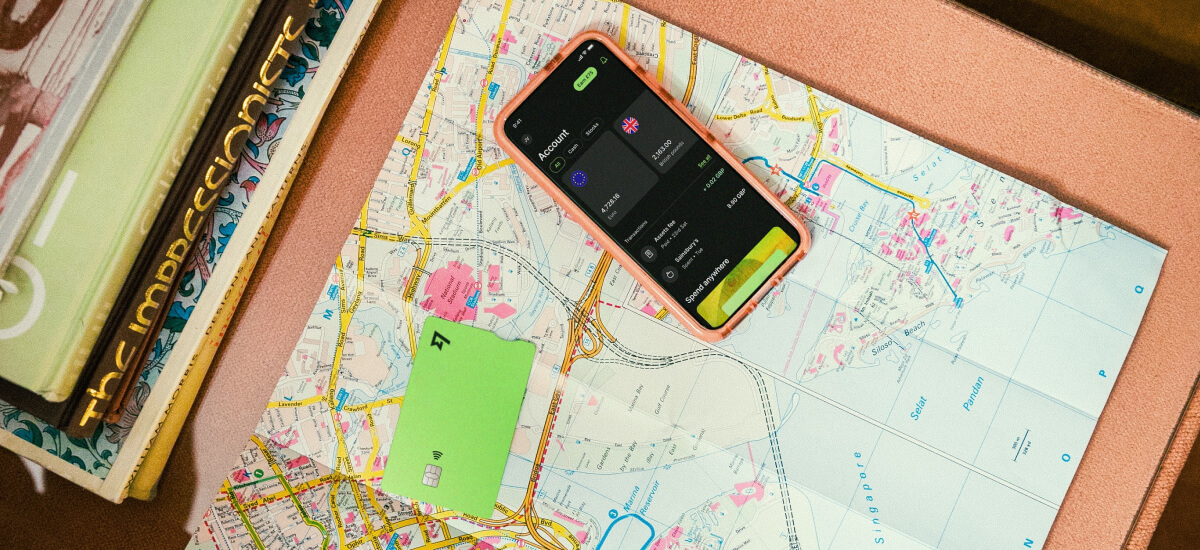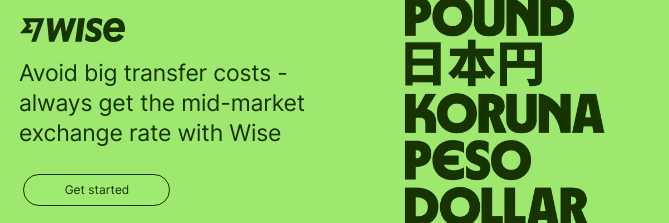
Money in Chile: what’s the currency, where to get it, banks and more
Getting acquainted with the money on your destination is a great starting point when planning a trip abroad.
So, if you’re wondering what type of currency does Chile use, what’s the meaning of CLP or what’s the Chilean peso symbol, you’ve come to the right place.
We’ll also cover alternatives to exchanging currency in Chile, the main banks of Chile and much more. So read along for all you need to know about Chilean money.
| 📑 Table of Contents |
|---|
What is the currency in Chile?
First off: what you came here for. The currency used in Chile is called Chilean Peso. It can also be written off as CLP or CL$.
The Chilean peso is what’s called a floating currency, which means that the exchange rate is set by supply and demand in the private market, with occasional intervention by the government to ensure stability¹.
What are the Chilean peso (CLP) bills and coins?
The Banco Central de Chile (Chilean Central Bank) is the institution that emits currency in Chile.
Currently the following bills and coins are in circulation:
| Chilean Peso Bills² | Chilean Peso Coins³ |
|---|---|
|
|
When traveling around Chile, it’s a good option to carry smaller notes with you, as it may be difficult to get change once you venture out of the main cities.
| Wondering how much CLP your USD is worth? Check out the conversion calculator below |
|---|
A brief history of Chilean currency
The peso was selected as the official currency of Chile first during colonial times. Bank notes were printed for some time in the US before production was moved back to Chile during the First World War.
High levels of inflation during the mid part of the 20th century led to the peso being replaced by the escudo in 1959. However, by 1975, a new law was passed reinstating pesos as the official currency, in an effort to make payment systems simpler and cheaper.
Over the years that followed, Chilean banknotes were modernized and started to be issued in the denominations mainly used today. From 2009 the most modern look of the peso came into production, retaining some historical features of the notes, and adding local natural images to the notes as well⁴.
Exchanging USD to CLP in Chile
The Chilean Peso isn’t usually considered a major currency. Banks and foreign exchange companies in the US may not have a readily available supply. Consequently, you probably won’t get a good exchange rate. While some places in Chile will accept dollars in payment, USD is not as commonly accepted here compared to other South American countries.
If you’re exchanging money on arrival in Chile, you’ll have a couple of choices — carry clean USD notes with you and exchange at one of the foreign exchange bureaus (casas de cambio); or use an ATM to make withdrawals.
You’d do well to avoid currency exchange kiosks at the airport and at major hotels as these rarely offer a good exchange rate. Instead, use an ATM or shop around once you arrive in downtown Santiago.
Always compare exchange rates you’re offered to the USD-CLP mid-market rate, so you’re sure you’re not getting ripped-off. It’s common for banks and foreign exchange kiosks to add a markup — an extra fee — to the exchange rate, which pushes up prices overall.
You can check the current mid-market rate by using our convenient online currency converter.
|
|---|
Currency exchange Santiago — Chile
Let’s take a quick look at some good options if you're changing USD to CLP in Santiago:
| Turismo Frontera⁵ | Well rated currency exchange store on Paseo San Agustín |
| Cambio Costero⁶ | Exchange currencies in person, or buy online and collect cash in the branch office |
| Guiñazu⁷ | Nationwide brand with a long history of currency exchange services |
A smart alternative which can help you save and do more with your money is the Wise multi-currency account. Open a Wise account online or in the Wise app, to hold and manage 40+ currencies including CLP. You’ll get the mid market exchange rate and low, transparent fees every time you switch currencies, and it’s always free to spend currencies you hold in your account. More on that coming right up.
Get started with Wise
in minutes!
Please see Terms of Use for your region or visit Wise Fees & Pricing for the most up to date pricing and fee information.
Alternatives to exchanging currency in Chile
Now that we’ve covered the most important aspects of exchanging currency in cash, we’ll walk you through a few alternatives that don’t require carrying all your money around in your wallet or travel money belt.
Get the Wise account
If you’re antsy about going to a different country carrying cash, don’t worry, you’re not alone.
A safe alternative to this is carrying a travel card, such as the Wise Multi-Currency Card.
Wise offers you an account to hold, send and spend money in over 40 currencies — including CLP.
You can set up your account while still in the US, convert the money to CLP using the mid-market exchange rate and use the Wise Multi-Currency Card like a local in Chile.
Fast, secure and cheap. Without all the stress of carrying your money around. It's as simple as that!
If you happen to have a bank account in Chile, you can also use Wise to send money to Chile and withdraw it directly from your local bank.
Learn more about the Wise Multi-Currency Card
Take travelers’ cheques to Chile
All around the world, traveler’s cheques are becoming less commonly used, as people prefer to rely on bank cards and ATMs for payments.
If you need to use traveler's checks you may find you can exchange them for CLP at some casas de cambio, but you’re unlikely to get a good rate. Expect a bad exchange rate and between 1% and 4% in commissions.
Exchanging cash or making an ATM withdrawal will often give you a much better rate. It’s also easier and much more convenient.
Pay with credit or debit cards in Chile
You’ll probably be able to pay with a card in more touristy areas. However, it’s rare to find places that accept card payments in villages and other rural areas.
If you plan on leaving the main tourist hotspots, make sure you have enough cash in your pocket to cover your expenses. Also, remember to tell your bank you’re traveling to avoid your card being blocked or limited while you’re away.
Where cards are accepted the most common networks are Visa, MasterCard and AmEx. Merchants may impose a 2% to 4% surcharge when you pay by card, which means paying in cash is often cheaper.
It’s also good to know that when you spend with your card overseas you may be offered Dynamic Currency Conversion (DCC). This is where you're asked if you’d prefer to pay in USD rather than CLP.
It sounds like a handy way to see exactly what you’re paying upfront — but actually you’re likely to get hit with a poor exchange rate and high costs. Pay in the local currency wherever you are to save money.
| Check out our full compilation of the best travel credit cards |
|---|
Withdraw money in Chilean ATMs
The two main ATM networks (cajero automático) in Chile are Redf and Redbanc. ATMs are widespread, even in rural areas. However, many tend to run out of cash after 4 PM, so it’s best to plan ahead.
It’s easier to find Cirrus and Maestro⁸ (MasterCard) ATMs versus Visa⁹ (Plus) and AmEx¹⁰ ATMs — check the logos displayed to see which cards can be used, or try one of the provider’s convenient online locators.
Most ATMs have an English language option. However, you’ll need to select extranjeros (foreign clients) after you key in your PIN in order to make a withdrawal with your foreign card.
ATMs offer the best exchange rates possible, but it’s important to know that DCC can also apply on ATM withdrawals. Always choose to be charged in the local currency to get the best rates available. Compare the best exchange rates of peso to avoid losing money when considering money exchange.
ATM fees and limits
Most banks in Chile charge an ATM usage fee of between 4,000 CLP and 7,000 CLP. You may even avoid local charges entirely if you find a Scotiabank ATM — but your own bank might still apply fees to your withdrawal¹¹.
Most Chilean ATMs will allow you to withdraw up to 200,000 CLP per transaction with a foreign card. Your bank back home may also have per transaction and daily limits on foreign ATM withdrawals.
What are the banks in Chile
Chances are that, if you’re going to Chile for travel, you won’t need to get an account from a local bank.
But it’s still a good option to be aware of the options if you need to make a deposit or withdraw money.
The most popular banks in Chile are:
- Banco de Chile¹²
- Santander Chile¹³
- Banco Estado¹⁴
- Itaú¹⁵
- Scotiabank Chile¹⁶
- HSBC Chile¹⁷
Before you travel to Chile — or anywhere else in the world — it’s well worth thinking about how you’ll manage your spending. Having access to low fee bank cards, finding smart ways to exchange cash, or using reliable ATMs can make it far easier to manage your costs and have a hassle free trip.
Make your money go further with the Wise multi-currency account. You’ll be able to top up in USD, exchange to CLP using the mid-market exchange rate and then spend and make withdrawals easily in Chile.
**Sources:**
- Investopedia - CLP
- Billetes Y Monedas - Familia billetes actuales
- Billetes Y Monedas - Familia monedas actuales
- Billetes Y Monedas - História billetes
- Turismo Frontera
- Cambio Costero
- Guinazu
- Visa ATM locator
- MasterCard ATM locator
- AmEx ATM locator
- ATM Travel Guide - ATMS in Chile
- Banco Chile
- Santander
- BancoEstado
- Itaú
- Scotiabank
- HSBC
Sources checked on 06.02.2022
*Please see terms of use and product availability for your region or visit Wise fees and pricing for the most up to date pricing and fee information.
This publication is provided for general information purposes and does not constitute legal, tax or other professional advice from Wise Payments Limited or its subsidiaries and its affiliates, and it is not intended as a substitute for obtaining advice from a financial advisor or any other professional.
We make no representations, warranties or guarantees, whether expressed or implied, that the content in the publication is accurate, complete or up to date.


